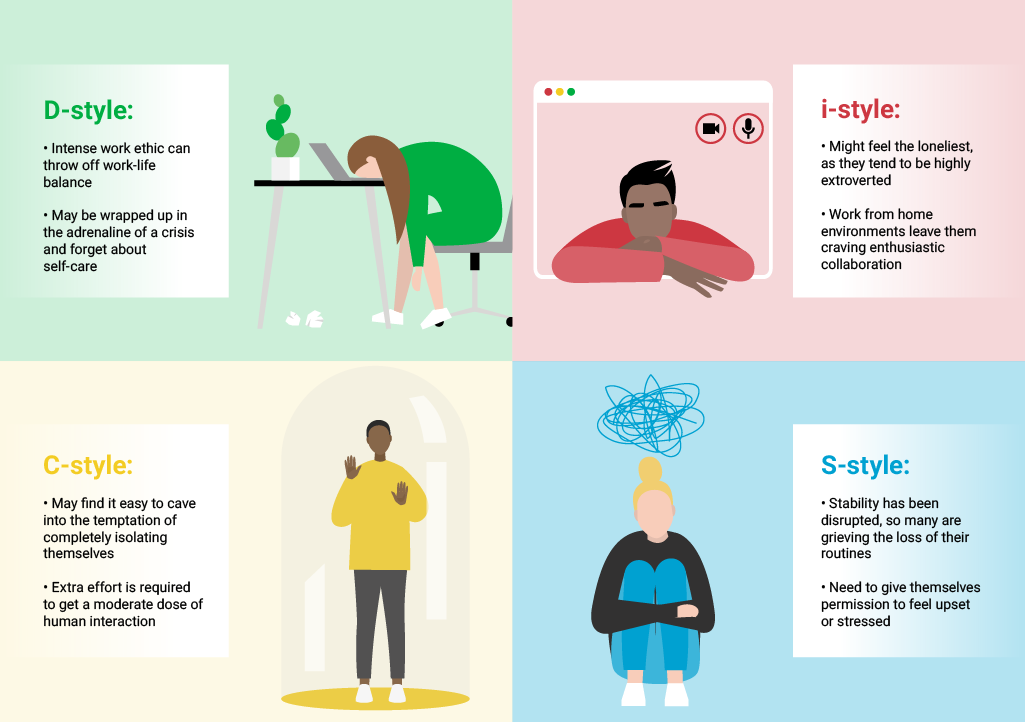Getting to Know YOU: Working from Home

May 07, 2020 | 6 min read
It’s a safe assumption that all of us have experienced our work lives being turned upside down over the past couple months. As organizations adapt to the mandates and changes brought on by COVID-19, a record-breaking number of people now find themselves working from home—including many who have never worked remotely until now.
There are advantages and drawbacks to this change of scenery, all of which vary from person to person. Are there children in the home that need to be taken care of throughout the workday? Does their home have adequate space to set up an efficient, comfortable workstation? Are they someone who enjoys working in isolation? Is there a reliable internet connection? These are just some of the factors that play into the ease (or difficulty) of this abrupt transition from the office to the kitchen table.

These challenges, while distracting and frustrating, can present an opportunity to deepen your own self-understanding. Asking yourself questions like: What has been the most difficult for me during this time? What has been easier? Why might that be happening? How can I make the most of this? can start to uncover new insight about yourself. And while there are many ways to answer these questions, one great place to start is with a proven personality assessment and learning experience like Everything DiSC®.
The DiSC model is a simple yet powerful model that describes four basic behavioral styles: D, i, S, and C, and serves as the foundation for each distinct Everything DiSC application.

D: Dominance
i: Influence
S: Steadiness
C: Conscientiousness
Everyone is a blend of all four DiSC styles—usually one, two, or even three styles stand out. Each person has a unique behavioral profile with different styles and priorities—no one style better or worse than the next. We believe that these differences in style can be extremely valuable. You can take a deeper dive into how the theory and model work together in our recent blog posts, Navigating the DiSC Model and Why Our Circumplex Model is Sp(here) to Stay.
So now that you have a grasp on DiSC, step two is understanding how each style might be experiencing their work from home situation based on their behavioral preferences and tendencies.

Keep in mind that each person and DiSC style is unique. Many people are a blend of two styles and find themselves grappling with more than one of the issues we presented above. That’s why utilizing a tool like Everything DiSC to help you uncover your own unique work style (including motivators, stressors, and the way you interact with others) can unlock new levels of self-awareness and understanding. And in a time where not much seems to make sense, exploring and building the relationships we have with ourselves can completely transform the way we work—no matter where that may be.
There are advantages and drawbacks to this change of scenery, all of which vary from person to person. Are there children in the home that need to be taken care of throughout the workday? Does their home have adequate space to set up an efficient, comfortable workstation? Are they someone who enjoys working in isolation? Is there a reliable internet connection? These are just some of the factors that play into the ease (or difficulty) of this abrupt transition from the office to the kitchen table.
So, how are people adjusting?
Wiley recently conducted a “Collaborating Virtually” study that asked nearly 3,000 business professionals a series of questions on how they’re handling this major—and sudden—shift in their work lives. What we learned was that 80% of those surveyed have either been encouraged or mandated to work from home. Of that sub-set, we learned that people are struggling (be it technically or mentally) to adapt to their new work from home lifestyle. Some of the most challenging aspects—outside of simply being tired of their surroundings—include:- balancing work and personal or family life
- feeling isolated
- experiencing poor communication with colleagues

These challenges, while distracting and frustrating, can present an opportunity to deepen your own self-understanding. Asking yourself questions like: What has been the most difficult for me during this time? What has been easier? Why might that be happening? How can I make the most of this? can start to uncover new insight about yourself. And while there are many ways to answer these questions, one great place to start is with a proven personality assessment and learning experience like Everything DiSC®.
How can DiSC® help deepen your own understanding of your preferences and tendencies in this new normal?
The first step is to understand the Everything DiSC model.The DiSC model is a simple yet powerful model that describes four basic behavioral styles: D, i, S, and C, and serves as the foundation for each distinct Everything DiSC application.

D: Dominance
i: Influence
S: Steadiness
C: Conscientiousness
Everyone is a blend of all four DiSC styles—usually one, two, or even three styles stand out. Each person has a unique behavioral profile with different styles and priorities—no one style better or worse than the next. We believe that these differences in style can be extremely valuable. You can take a deeper dive into how the theory and model work together in our recent blog posts, Navigating the DiSC Model and Why Our Circumplex Model is Sp(here) to Stay.
So now that you have a grasp on DiSC, step two is understanding how each style might be experiencing their work from home situation based on their behavioral preferences and tendencies.

